Essay: Defamation Laws, Internet Intermediaries, and Australia
VerifiedAdded on 2023/06/04
|11
|5317
|422
Essay
AI Summary
This essay provides a comprehensive overview of defamation laws, particularly within the context of the internet and its intermediaries in Australia. It begins by defining defamation and its core principles, emphasizing the balance between protecting personal reputation and freedom of communication. The essay explores the legal responsibilities of internet service providers, website hosts, and social media platforms, examining various liability models such as strict liability, safe harbour, broad immunity, notice-and-notice, and the generalist model. The discussion includes relevant Australian legislation and case law, highlighting the challenges of applying existing defamation principles to online publications. The essay further delves into criminal and civil defamation, the elements required to establish a defamation claim, and the defenses available. It also examines the concept of publication, the impact of defamatory statements, and the limitations on entities bringing defamation claims, offering a thorough analysis of the legal landscape surrounding defamation in the digital age.
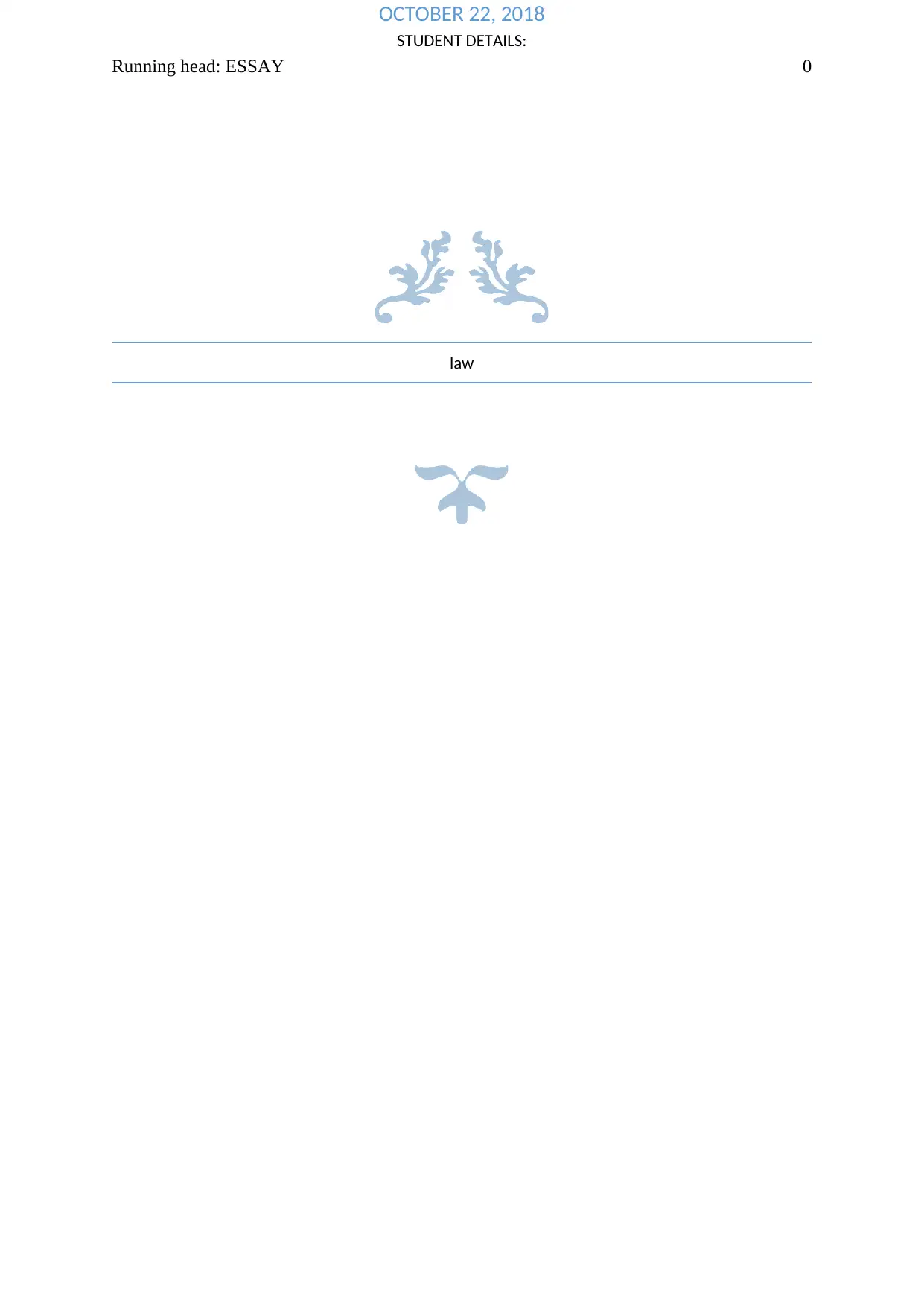
Running head: ESSAY 0
law
OCTOBER 22, 2018
STUDENT DETAILS:
law
OCTOBER 22, 2018
STUDENT DETAILS:
Paraphrase This Document
Need a fresh take? Get an instant paraphrase of this document with our AI Paraphraser
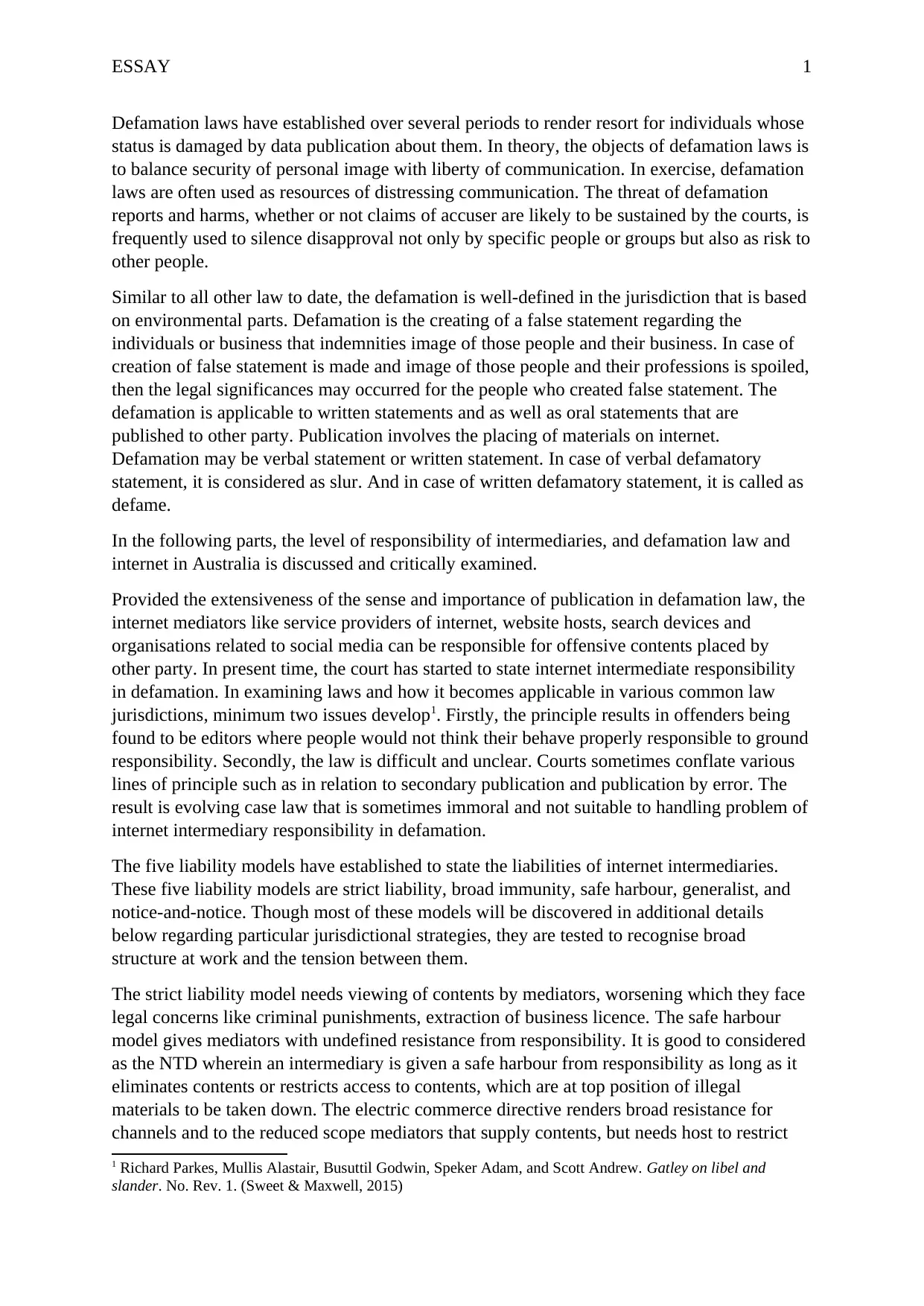
ESSAY 1
Defamation laws have established over several periods to render resort for individuals whose
status is damaged by data publication about them. In theory, the objects of defamation laws is
to balance security of personal image with liberty of communication. In exercise, defamation
laws are often used as resources of distressing communication. The threat of defamation
reports and harms, whether or not claims of accuser are likely to be sustained by the courts, is
frequently used to silence disapproval not only by specific people or groups but also as risk to
other people.
Similar to all other law to date, the defamation is well-defined in the jurisdiction that is based
on environmental parts. Defamation is the creating of a false statement regarding the
individuals or business that indemnities image of those people and their business. In case of
creation of false statement is made and image of those people and their professions is spoiled,
then the legal significances may occurred for the people who created false statement. The
defamation is applicable to written statements and as well as oral statements that are
published to other party. Publication involves the placing of materials on internet.
Defamation may be verbal statement or written statement. In case of verbal defamatory
statement, it is considered as slur. And in case of written defamatory statement, it is called as
defame.
In the following parts, the level of responsibility of intermediaries, and defamation law and
internet in Australia is discussed and critically examined.
Provided the extensiveness of the sense and importance of publication in defamation law, the
internet mediators like service providers of internet, website hosts, search devices and
organisations related to social media can be responsible for offensive contents placed by
other party. In present time, the court has started to state internet intermediate responsibility
in defamation. In examining laws and how it becomes applicable in various common law
jurisdictions, minimum two issues develop1. Firstly, the principle results in offenders being
found to be editors where people would not think their behave properly responsible to ground
responsibility. Secondly, the law is difficult and unclear. Courts sometimes conflate various
lines of principle such as in relation to secondary publication and publication by error. The
result is evolving case law that is sometimes immoral and not suitable to handling problem of
internet intermediary responsibility in defamation.
The five liability models have established to state the liabilities of internet intermediaries.
These five liability models are strict liability, broad immunity, safe harbour, generalist, and
notice-and-notice. Though most of these models will be discovered in additional details
below regarding particular jurisdictional strategies, they are tested to recognise broad
structure at work and the tension between them.
The strict liability model needs viewing of contents by mediators, worsening which they face
legal concerns like criminal punishments, extraction of business licence. The safe harbour
model gives mediators with undefined resistance from responsibility. It is good to considered
as the NTD wherein an intermediary is given a safe harbour from responsibility as long as it
eliminates contents or restricts access to contents, which are at top position of illegal
materials to be taken down. The electric commerce directive renders broad resistance for
channels and to the reduced scope mediators that supply contents, but needs host to restrict
1 Richard Parkes, Mullis Alastair, Busuttil Godwin, Speker Adam, and Scott Andrew. Gatley on libel and
slander. No. Rev. 1. (Sweet & Maxwell, 2015)
Defamation laws have established over several periods to render resort for individuals whose
status is damaged by data publication about them. In theory, the objects of defamation laws is
to balance security of personal image with liberty of communication. In exercise, defamation
laws are often used as resources of distressing communication. The threat of defamation
reports and harms, whether or not claims of accuser are likely to be sustained by the courts, is
frequently used to silence disapproval not only by specific people or groups but also as risk to
other people.
Similar to all other law to date, the defamation is well-defined in the jurisdiction that is based
on environmental parts. Defamation is the creating of a false statement regarding the
individuals or business that indemnities image of those people and their business. In case of
creation of false statement is made and image of those people and their professions is spoiled,
then the legal significances may occurred for the people who created false statement. The
defamation is applicable to written statements and as well as oral statements that are
published to other party. Publication involves the placing of materials on internet.
Defamation may be verbal statement or written statement. In case of verbal defamatory
statement, it is considered as slur. And in case of written defamatory statement, it is called as
defame.
In the following parts, the level of responsibility of intermediaries, and defamation law and
internet in Australia is discussed and critically examined.
Provided the extensiveness of the sense and importance of publication in defamation law, the
internet mediators like service providers of internet, website hosts, search devices and
organisations related to social media can be responsible for offensive contents placed by
other party. In present time, the court has started to state internet intermediate responsibility
in defamation. In examining laws and how it becomes applicable in various common law
jurisdictions, minimum two issues develop1. Firstly, the principle results in offenders being
found to be editors where people would not think their behave properly responsible to ground
responsibility. Secondly, the law is difficult and unclear. Courts sometimes conflate various
lines of principle such as in relation to secondary publication and publication by error. The
result is evolving case law that is sometimes immoral and not suitable to handling problem of
internet intermediary responsibility in defamation.
The five liability models have established to state the liabilities of internet intermediaries.
These five liability models are strict liability, broad immunity, safe harbour, generalist, and
notice-and-notice. Though most of these models will be discovered in additional details
below regarding particular jurisdictional strategies, they are tested to recognise broad
structure at work and the tension between them.
The strict liability model needs viewing of contents by mediators, worsening which they face
legal concerns like criminal punishments, extraction of business licence. The safe harbour
model gives mediators with undefined resistance from responsibility. It is good to considered
as the NTD wherein an intermediary is given a safe harbour from responsibility as long as it
eliminates contents or restricts access to contents, which are at top position of illegal
materials to be taken down. The electric commerce directive renders broad resistance for
channels and to the reduced scope mediators that supply contents, but needs host to restrict
1 Richard Parkes, Mullis Alastair, Busuttil Godwin, Speker Adam, and Scott Andrew. Gatley on libel and
slander. No. Rev. 1. (Sweet & Maxwell, 2015)
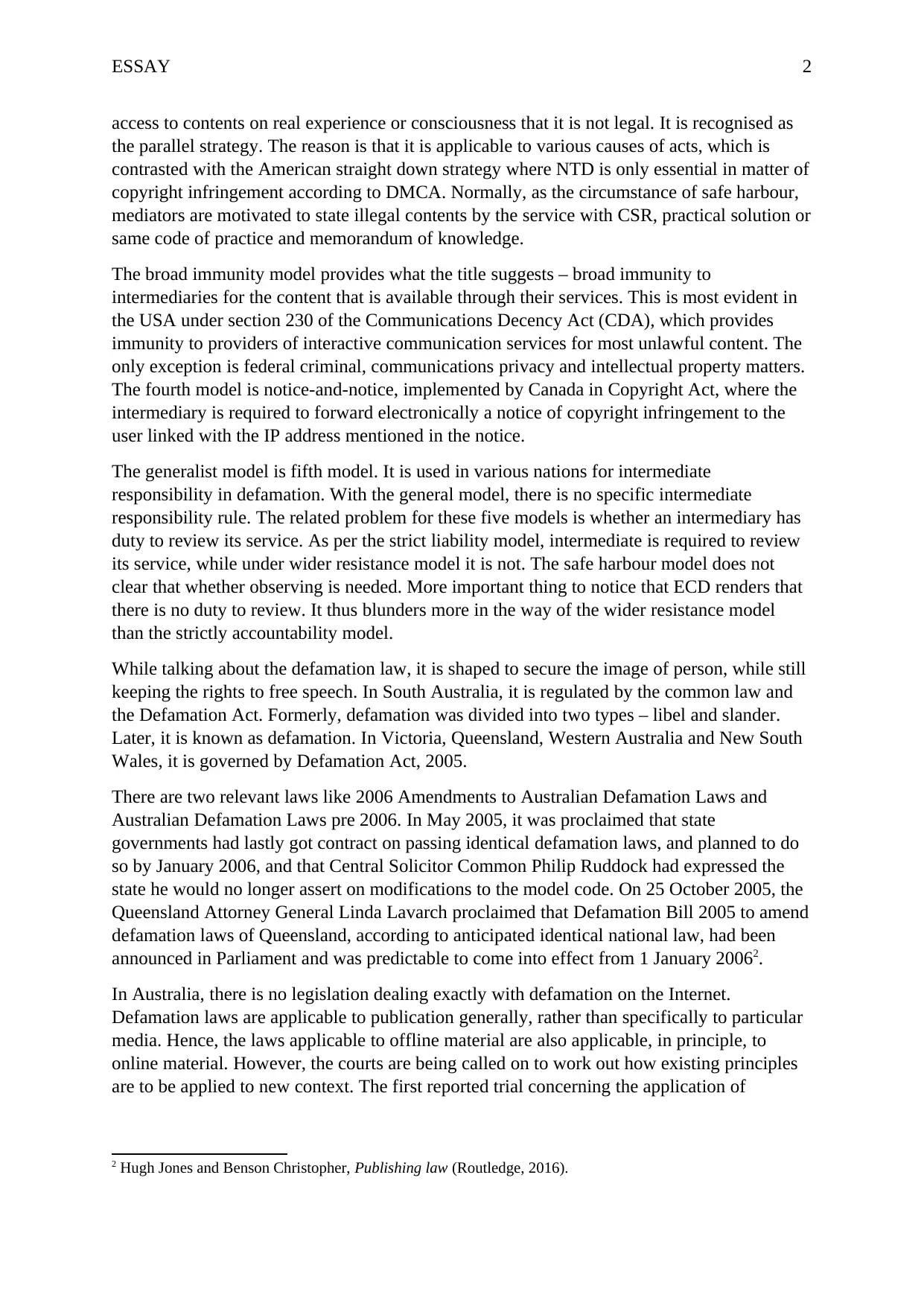
ESSAY 2
access to contents on real experience or consciousness that it is not legal. It is recognised as
the parallel strategy. The reason is that it is applicable to various causes of acts, which is
contrasted with the American straight down strategy where NTD is only essential in matter of
copyright infringement according to DMCA. Normally, as the circumstance of safe harbour,
mediators are motivated to state illegal contents by the service with CSR, practical solution or
same code of practice and memorandum of knowledge.
The broad immunity model provides what the title suggests – broad immunity to
intermediaries for the content that is available through their services. This is most evident in
the USA under section 230 of the Communications Decency Act (CDA), which provides
immunity to providers of interactive communication services for most unlawful content. The
only exception is federal criminal, communications privacy and intellectual property matters.
The fourth model is notice-and-notice, implemented by Canada in Copyright Act, where the
intermediary is required to forward electronically a notice of copyright infringement to the
user linked with the IP address mentioned in the notice.
The generalist model is fifth model. It is used in various nations for intermediate
responsibility in defamation. With the general model, there is no specific intermediate
responsibility rule. The related problem for these five models is whether an intermediary has
duty to review its service. As per the strict liability model, intermediate is required to review
its service, while under wider resistance model it is not. The safe harbour model does not
clear that whether observing is needed. More important thing to notice that ECD renders that
there is no duty to review. It thus blunders more in the way of the wider resistance model
than the strictly accountability model.
While talking about the defamation law, it is shaped to secure the image of person, while still
keeping the rights to free speech. In South Australia, it is regulated by the common law and
the Defamation Act. Formerly, defamation was divided into two types – libel and slander.
Later, it is known as defamation. In Victoria, Queensland, Western Australia and New South
Wales, it is governed by Defamation Act, 2005.
There are two relevant laws like 2006 Amendments to Australian Defamation Laws and
Australian Defamation Laws pre 2006. In May 2005, it was proclaimed that state
governments had lastly got contract on passing identical defamation laws, and planned to do
so by January 2006, and that Central Solicitor Common Philip Ruddock had expressed the
state he would no longer assert on modifications to the model code. On 25 October 2005, the
Queensland Attorney General Linda Lavarch proclaimed that Defamation Bill 2005 to amend
defamation laws of Queensland, according to anticipated identical national law, had been
announced in Parliament and was predictable to come into effect from 1 January 20062.
In Australia, there is no legislation dealing exactly with defamation on the Internet.
Defamation laws are applicable to publication generally, rather than specifically to particular
media. Hence, the laws applicable to offline material are also applicable, in principle, to
online material. However, the courts are being called on to work out how existing principles
are to be applied to new context. The first reported trial concerning the application of
2 Hugh Jones and Benson Christopher, Publishing law (Routledge, 2016).
access to contents on real experience or consciousness that it is not legal. It is recognised as
the parallel strategy. The reason is that it is applicable to various causes of acts, which is
contrasted with the American straight down strategy where NTD is only essential in matter of
copyright infringement according to DMCA. Normally, as the circumstance of safe harbour,
mediators are motivated to state illegal contents by the service with CSR, practical solution or
same code of practice and memorandum of knowledge.
The broad immunity model provides what the title suggests – broad immunity to
intermediaries for the content that is available through their services. This is most evident in
the USA under section 230 of the Communications Decency Act (CDA), which provides
immunity to providers of interactive communication services for most unlawful content. The
only exception is federal criminal, communications privacy and intellectual property matters.
The fourth model is notice-and-notice, implemented by Canada in Copyright Act, where the
intermediary is required to forward electronically a notice of copyright infringement to the
user linked with the IP address mentioned in the notice.
The generalist model is fifth model. It is used in various nations for intermediate
responsibility in defamation. With the general model, there is no specific intermediate
responsibility rule. The related problem for these five models is whether an intermediary has
duty to review its service. As per the strict liability model, intermediate is required to review
its service, while under wider resistance model it is not. The safe harbour model does not
clear that whether observing is needed. More important thing to notice that ECD renders that
there is no duty to review. It thus blunders more in the way of the wider resistance model
than the strictly accountability model.
While talking about the defamation law, it is shaped to secure the image of person, while still
keeping the rights to free speech. In South Australia, it is regulated by the common law and
the Defamation Act. Formerly, defamation was divided into two types – libel and slander.
Later, it is known as defamation. In Victoria, Queensland, Western Australia and New South
Wales, it is governed by Defamation Act, 2005.
There are two relevant laws like 2006 Amendments to Australian Defamation Laws and
Australian Defamation Laws pre 2006. In May 2005, it was proclaimed that state
governments had lastly got contract on passing identical defamation laws, and planned to do
so by January 2006, and that Central Solicitor Common Philip Ruddock had expressed the
state he would no longer assert on modifications to the model code. On 25 October 2005, the
Queensland Attorney General Linda Lavarch proclaimed that Defamation Bill 2005 to amend
defamation laws of Queensland, according to anticipated identical national law, had been
announced in Parliament and was predictable to come into effect from 1 January 20062.
In Australia, there is no legislation dealing exactly with defamation on the Internet.
Defamation laws are applicable to publication generally, rather than specifically to particular
media. Hence, the laws applicable to offline material are also applicable, in principle, to
online material. However, the courts are being called on to work out how existing principles
are to be applied to new context. The first reported trial concerning the application of
2 Hugh Jones and Benson Christopher, Publishing law (Routledge, 2016).
⊘ This is a preview!⊘
Do you want full access?
Subscribe today to unlock all pages.

Trusted by 1+ million students worldwide
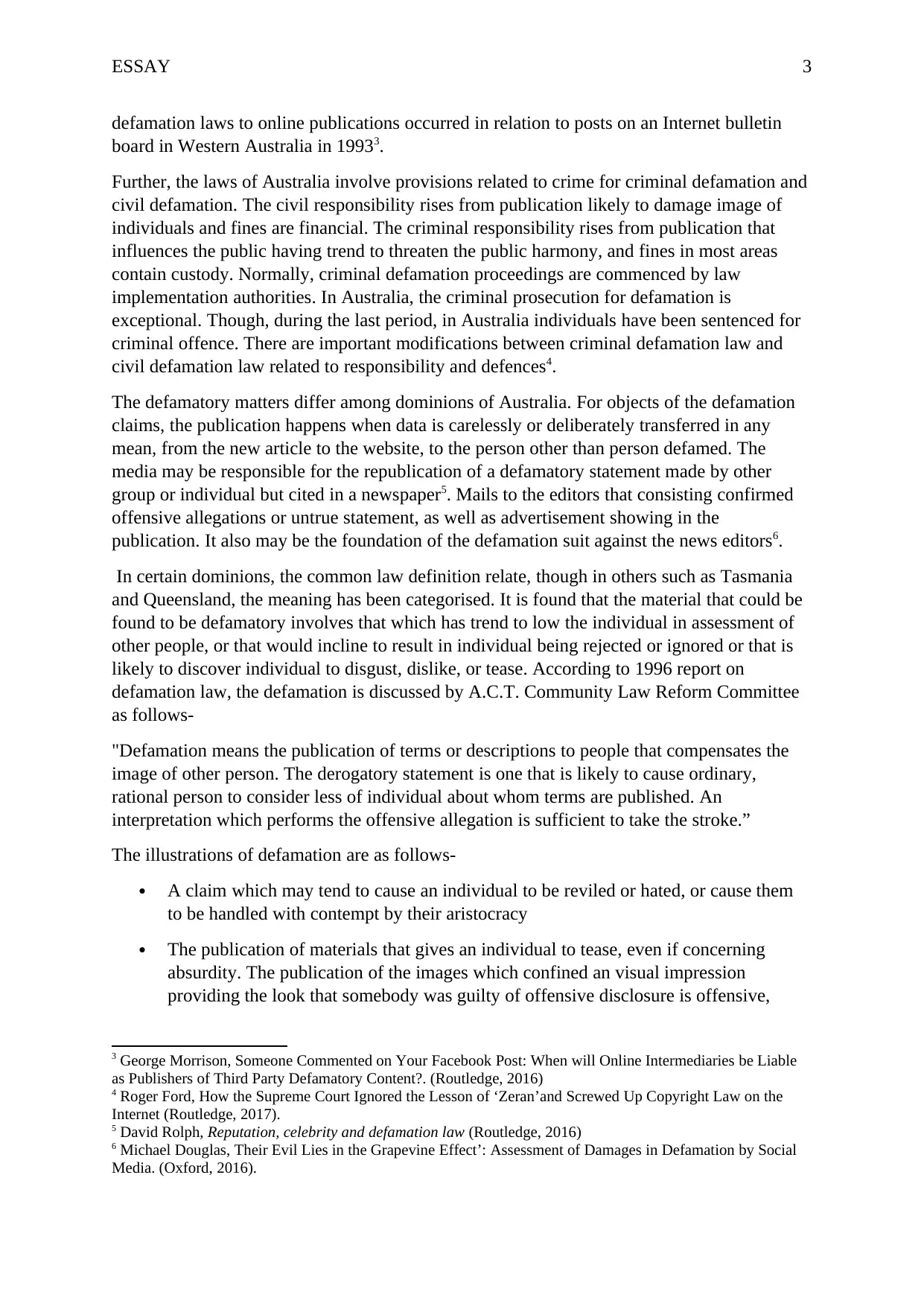
ESSAY 3
defamation laws to online publications occurred in relation to posts on an Internet bulletin
board in Western Australia in 19933.
Further, the laws of Australia involve provisions related to crime for criminal defamation and
civil defamation. The civil responsibility rises from publication likely to damage image of
individuals and fines are financial. The criminal responsibility rises from publication that
influences the public having trend to threaten the public harmony, and fines in most areas
contain custody. Normally, criminal defamation proceedings are commenced by law
implementation authorities. In Australia, the criminal prosecution for defamation is
exceptional. Though, during the last period, in Australia individuals have been sentenced for
criminal offence. There are important modifications between criminal defamation law and
civil defamation law related to responsibility and defences4.
The defamatory matters differ among dominions of Australia. For objects of the defamation
claims, the publication happens when data is carelessly or deliberately transferred in any
mean, from the new article to the website, to the person other than person defamed. The
media may be responsible for the republication of a defamatory statement made by other
group or individual but cited in a newspaper5. Mails to the editors that consisting confirmed
offensive allegations or untrue statement, as well as advertisement showing in the
publication. It also may be the foundation of the defamation suit against the news editors6.
In certain dominions, the common law definition relate, though in others such as Tasmania
and Queensland, the meaning has been categorised. It is found that the material that could be
found to be defamatory involves that which has trend to low the individual in assessment of
other people, or that would incline to result in individual being rejected or ignored or that is
likely to discover individual to disgust, dislike, or tease. According to 1996 report on
defamation law, the defamation is discussed by A.C.T. Community Law Reform Committee
as follows-
"Defamation means the publication of terms or descriptions to people that compensates the
image of other person. The derogatory statement is one that is likely to cause ordinary,
rational person to consider less of individual about whom terms are published. An
interpretation which performs the offensive allegation is sufficient to take the stroke.”
The illustrations of defamation are as follows-
A claim which may tend to cause an individual to be reviled or hated, or cause them
to be handled with contempt by their aristocracy
The publication of materials that gives an individual to tease, even if concerning
absurdity. The publication of the images which confined an visual impression
providing the look that somebody was guilty of offensive disclosure is offensive,
3 George Morrison, Someone Commented on Your Facebook Post: When will Online Intermediaries be Liable
as Publishers of Third Party Defamatory Content?. (Routledge, 2016)
4 Roger Ford, How the Supreme Court Ignored the Lesson of ‘Zeran’and Screwed Up Copyright Law on the
Internet (Routledge, 2017).
5 David Rolph, Reputation, celebrity and defamation law (Routledge, 2016)
6 Michael Douglas, Their Evil Lies in the Grapevine Effect’: Assessment of Damages in Defamation by Social
Media. (Oxford, 2016).
defamation laws to online publications occurred in relation to posts on an Internet bulletin
board in Western Australia in 19933.
Further, the laws of Australia involve provisions related to crime for criminal defamation and
civil defamation. The civil responsibility rises from publication likely to damage image of
individuals and fines are financial. The criminal responsibility rises from publication that
influences the public having trend to threaten the public harmony, and fines in most areas
contain custody. Normally, criminal defamation proceedings are commenced by law
implementation authorities. In Australia, the criminal prosecution for defamation is
exceptional. Though, during the last period, in Australia individuals have been sentenced for
criminal offence. There are important modifications between criminal defamation law and
civil defamation law related to responsibility and defences4.
The defamatory matters differ among dominions of Australia. For objects of the defamation
claims, the publication happens when data is carelessly or deliberately transferred in any
mean, from the new article to the website, to the person other than person defamed. The
media may be responsible for the republication of a defamatory statement made by other
group or individual but cited in a newspaper5. Mails to the editors that consisting confirmed
offensive allegations or untrue statement, as well as advertisement showing in the
publication. It also may be the foundation of the defamation suit against the news editors6.
In certain dominions, the common law definition relate, though in others such as Tasmania
and Queensland, the meaning has been categorised. It is found that the material that could be
found to be defamatory involves that which has trend to low the individual in assessment of
other people, or that would incline to result in individual being rejected or ignored or that is
likely to discover individual to disgust, dislike, or tease. According to 1996 report on
defamation law, the defamation is discussed by A.C.T. Community Law Reform Committee
as follows-
"Defamation means the publication of terms or descriptions to people that compensates the
image of other person. The derogatory statement is one that is likely to cause ordinary,
rational person to consider less of individual about whom terms are published. An
interpretation which performs the offensive allegation is sufficient to take the stroke.”
The illustrations of defamation are as follows-
A claim which may tend to cause an individual to be reviled or hated, or cause them
to be handled with contempt by their aristocracy
The publication of materials that gives an individual to tease, even if concerning
absurdity. The publication of the images which confined an visual impression
providing the look that somebody was guilty of offensive disclosure is offensive,
3 George Morrison, Someone Commented on Your Facebook Post: When will Online Intermediaries be Liable
as Publishers of Third Party Defamatory Content?. (Routledge, 2016)
4 Roger Ford, How the Supreme Court Ignored the Lesson of ‘Zeran’and Screwed Up Copyright Law on the
Internet (Routledge, 2017).
5 David Rolph, Reputation, celebrity and defamation law (Routledge, 2016)
6 Michael Douglas, Their Evil Lies in the Grapevine Effect’: Assessment of Damages in Defamation by Social
Media. (Oxford, 2016).
Paraphrase This Document
Need a fresh take? Get an instant paraphrase of this document with our AI Paraphraser
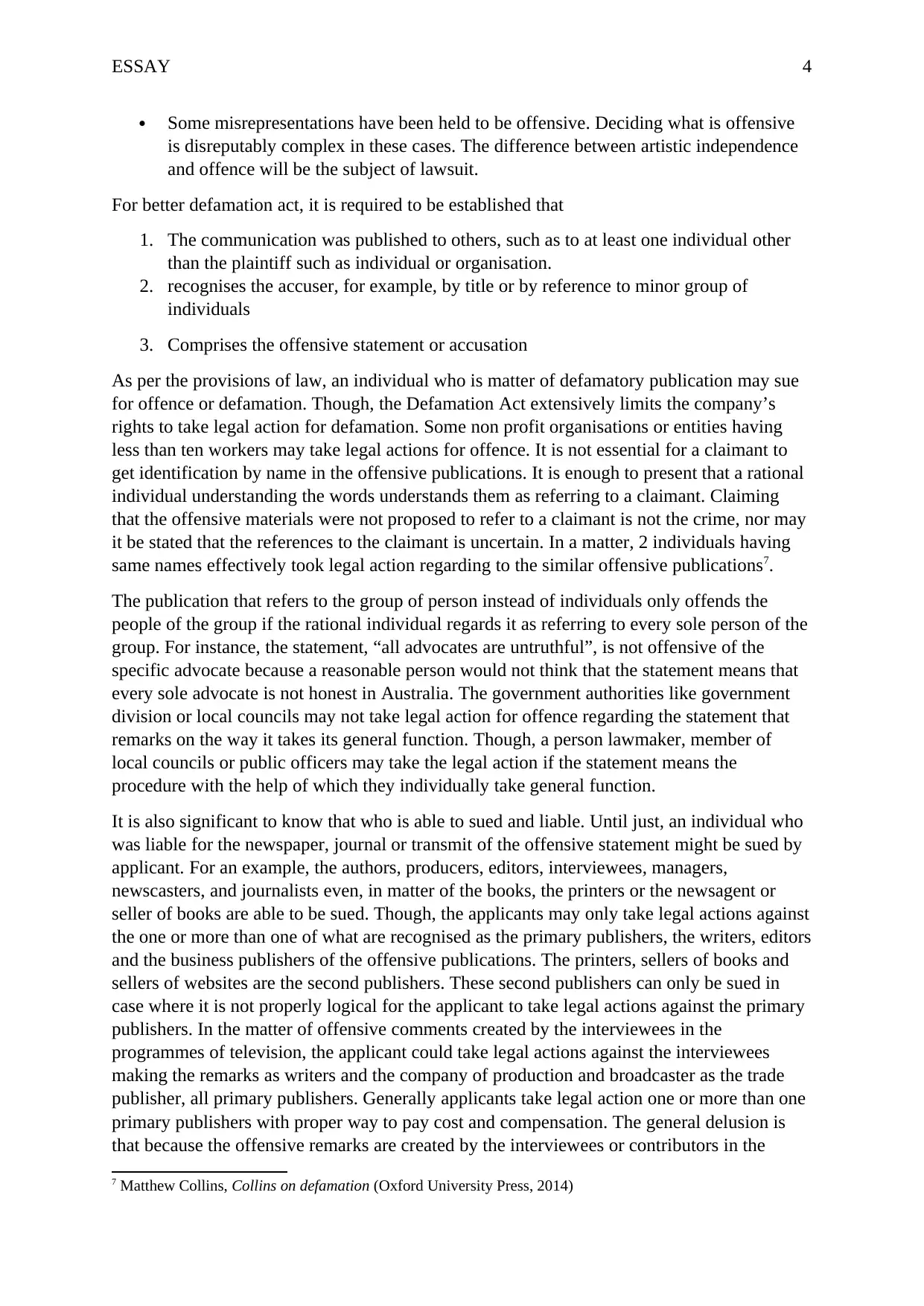
ESSAY 4
Some misrepresentations have been held to be offensive. Deciding what is offensive
is disreputably complex in these cases. The difference between artistic independence
and offence will be the subject of lawsuit.
For better defamation act, it is required to be established that
1. The communication was published to others, such as to at least one individual other
than the plaintiff such as individual or organisation.
2. recognises the accuser, for example, by title or by reference to minor group of
individuals
3. Comprises the offensive statement or accusation
As per the provisions of law, an individual who is matter of defamatory publication may sue
for offence or defamation. Though, the Defamation Act extensively limits the company’s
rights to take legal action for defamation. Some non profit organisations or entities having
less than ten workers may take legal actions for offence. It is not essential for a claimant to
get identification by name in the offensive publications. It is enough to present that a rational
individual understanding the words understands them as referring to a claimant. Claiming
that the offensive materials were not proposed to refer to a claimant is not the crime, nor may
it be stated that the references to the claimant is uncertain. In a matter, 2 individuals having
same names effectively took legal action regarding to the similar offensive publications7.
The publication that refers to the group of person instead of individuals only offends the
people of the group if the rational individual regards it as referring to every sole person of the
group. For instance, the statement, “all advocates are untruthful”, is not offensive of the
specific advocate because a reasonable person would not think that the statement means that
every sole advocate is not honest in Australia. The government authorities like government
division or local councils may not take legal action for offence regarding the statement that
remarks on the way it takes its general function. Though, a person lawmaker, member of
local councils or public officers may take the legal action if the statement means the
procedure with the help of which they individually take general function.
It is also significant to know that who is able to sued and liable. Until just, an individual who
was liable for the newspaper, journal or transmit of the offensive statement might be sued by
applicant. For an example, the authors, producers, editors, interviewees, managers,
newscasters, and journalists even, in matter of the books, the printers or the newsagent or
seller of books are able to be sued. Though, the applicants may only take legal actions against
the one or more than one of what are recognised as the primary publishers, the writers, editors
and the business publishers of the offensive publications. The printers, sellers of books and
sellers of websites are the second publishers. These second publishers can only be sued in
case where it is not properly logical for the applicant to take legal actions against the primary
publishers. In the matter of offensive comments created by the interviewees in the
programmes of television, the applicant could take legal actions against the interviewees
making the remarks as writers and the company of production and broadcaster as the trade
publisher, all primary publishers. Generally applicants take legal action one or more than one
primary publishers with proper way to pay cost and compensation. The general delusion is
that because the offensive remarks are created by the interviewees or contributors in the
7 Matthew Collins, Collins on defamation (Oxford University Press, 2014)
Some misrepresentations have been held to be offensive. Deciding what is offensive
is disreputably complex in these cases. The difference between artistic independence
and offence will be the subject of lawsuit.
For better defamation act, it is required to be established that
1. The communication was published to others, such as to at least one individual other
than the plaintiff such as individual or organisation.
2. recognises the accuser, for example, by title or by reference to minor group of
individuals
3. Comprises the offensive statement or accusation
As per the provisions of law, an individual who is matter of defamatory publication may sue
for offence or defamation. Though, the Defamation Act extensively limits the company’s
rights to take legal action for defamation. Some non profit organisations or entities having
less than ten workers may take legal actions for offence. It is not essential for a claimant to
get identification by name in the offensive publications. It is enough to present that a rational
individual understanding the words understands them as referring to a claimant. Claiming
that the offensive materials were not proposed to refer to a claimant is not the crime, nor may
it be stated that the references to the claimant is uncertain. In a matter, 2 individuals having
same names effectively took legal action regarding to the similar offensive publications7.
The publication that refers to the group of person instead of individuals only offends the
people of the group if the rational individual regards it as referring to every sole person of the
group. For instance, the statement, “all advocates are untruthful”, is not offensive of the
specific advocate because a reasonable person would not think that the statement means that
every sole advocate is not honest in Australia. The government authorities like government
division or local councils may not take legal action for offence regarding the statement that
remarks on the way it takes its general function. Though, a person lawmaker, member of
local councils or public officers may take the legal action if the statement means the
procedure with the help of which they individually take general function.
It is also significant to know that who is able to sued and liable. Until just, an individual who
was liable for the newspaper, journal or transmit of the offensive statement might be sued by
applicant. For an example, the authors, producers, editors, interviewees, managers,
newscasters, and journalists even, in matter of the books, the printers or the newsagent or
seller of books are able to be sued. Though, the applicants may only take legal actions against
the one or more than one of what are recognised as the primary publishers, the writers, editors
and the business publishers of the offensive publications. The printers, sellers of books and
sellers of websites are the second publishers. These second publishers can only be sued in
case where it is not properly logical for the applicant to take legal actions against the primary
publishers. In the matter of offensive comments created by the interviewees in the
programmes of television, the applicant could take legal actions against the interviewees
making the remarks as writers and the company of production and broadcaster as the trade
publisher, all primary publishers. Generally applicants take legal action one or more than one
primary publishers with proper way to pay cost and compensation. The general delusion is
that because the offensive remarks are created by the interviewees or contributors in the
7 Matthew Collins, Collins on defamation (Oxford University Press, 2014)
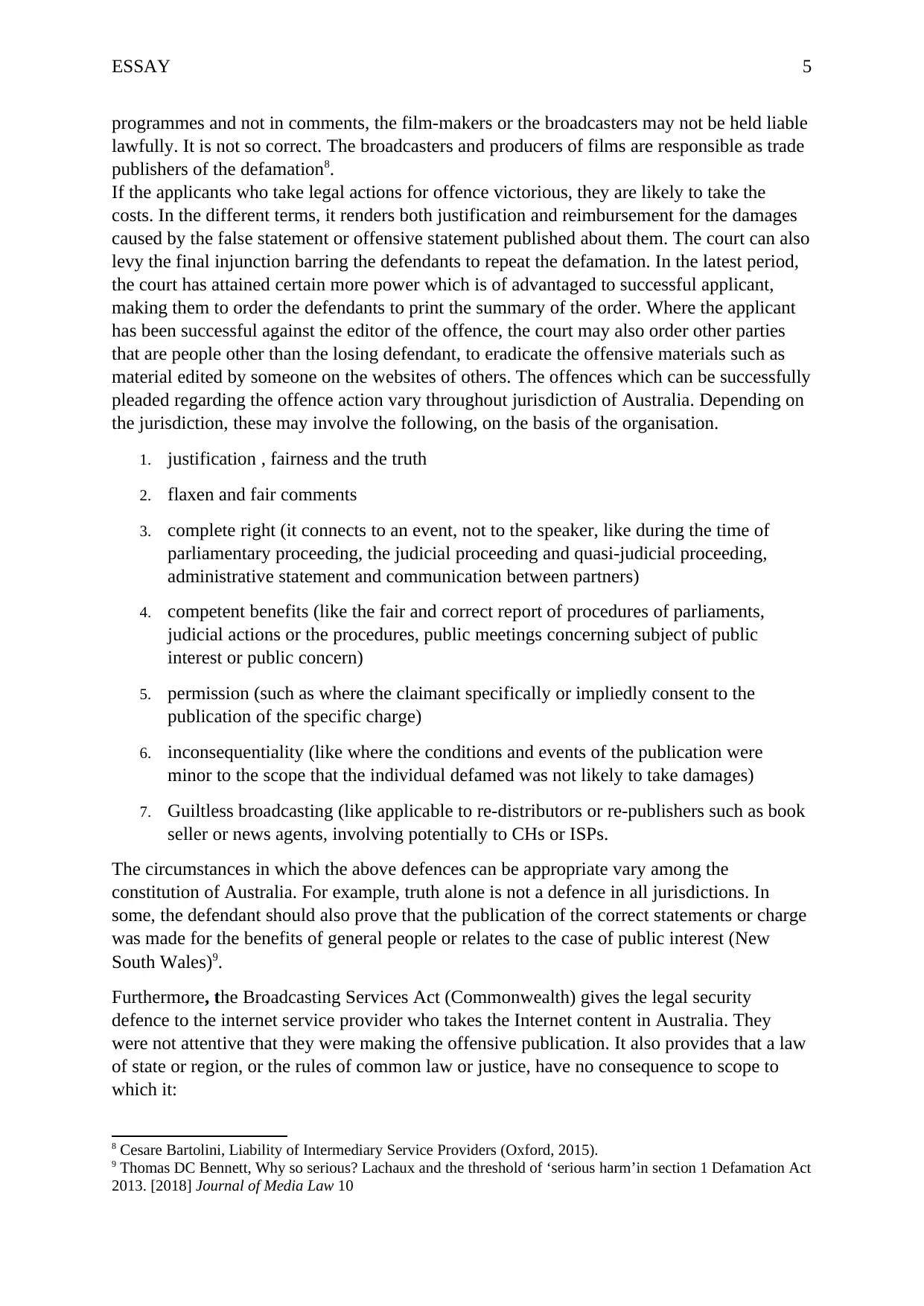
ESSAY 5
programmes and not in comments, the film-makers or the broadcasters may not be held liable
lawfully. It is not so correct. The broadcasters and producers of films are responsible as trade
publishers of the defamation8.
If the applicants who take legal actions for offence victorious, they are likely to take the
costs. In the different terms, it renders both justification and reimbursement for the damages
caused by the false statement or offensive statement published about them. The court can also
levy the final injunction barring the defendants to repeat the defamation. In the latest period,
the court has attained certain more power which is of advantaged to successful applicant,
making them to order the defendants to print the summary of the order. Where the applicant
has been successful against the editor of the offence, the court may also order other parties
that are people other than the losing defendant, to eradicate the offensive materials such as
material edited by someone on the websites of others. The offences which can be successfully
pleaded regarding the offence action vary throughout jurisdiction of Australia. Depending on
the jurisdiction, these may involve the following, on the basis of the organisation.
1. justification , fairness and the truth
2. flaxen and fair comments
3. complete right (it connects to an event, not to the speaker, like during the time of
parliamentary proceeding, the judicial proceeding and quasi-judicial proceeding,
administrative statement and communication between partners)
4. competent benefits (like the fair and correct report of procedures of parliaments,
judicial actions or the procedures, public meetings concerning subject of public
interest or public concern)
5. permission (such as where the claimant specifically or impliedly consent to the
publication of the specific charge)
6. inconsequentiality (like where the conditions and events of the publication were
minor to the scope that the individual defamed was not likely to take damages)
7. Guiltless broadcasting (like applicable to re-distributors or re-publishers such as book
seller or news agents, involving potentially to CHs or ISPs.
The circumstances in which the above defences can be appropriate vary among the
constitution of Australia. For example, truth alone is not a defence in all jurisdictions. In
some, the defendant should also prove that the publication of the correct statements or charge
was made for the benefits of general people or relates to the case of public interest (New
South Wales)9.
Furthermore, the Broadcasting Services Act (Commonwealth) gives the legal security
defence to the internet service provider who takes the Internet content in Australia. They
were not attentive that they were making the offensive publication. It also provides that a law
of state or region, or the rules of common law or justice, have no consequence to scope to
which it:
8 Cesare Bartolini, Liability of Intermediary Service Providers (Oxford, 2015).
9 Thomas DC Bennett, Why so serious? Lachaux and the threshold of ‘serious harm’in section 1 Defamation Act
2013. [2018] Journal of Media Law 10
programmes and not in comments, the film-makers or the broadcasters may not be held liable
lawfully. It is not so correct. The broadcasters and producers of films are responsible as trade
publishers of the defamation8.
If the applicants who take legal actions for offence victorious, they are likely to take the
costs. In the different terms, it renders both justification and reimbursement for the damages
caused by the false statement or offensive statement published about them. The court can also
levy the final injunction barring the defendants to repeat the defamation. In the latest period,
the court has attained certain more power which is of advantaged to successful applicant,
making them to order the defendants to print the summary of the order. Where the applicant
has been successful against the editor of the offence, the court may also order other parties
that are people other than the losing defendant, to eradicate the offensive materials such as
material edited by someone on the websites of others. The offences which can be successfully
pleaded regarding the offence action vary throughout jurisdiction of Australia. Depending on
the jurisdiction, these may involve the following, on the basis of the organisation.
1. justification , fairness and the truth
2. flaxen and fair comments
3. complete right (it connects to an event, not to the speaker, like during the time of
parliamentary proceeding, the judicial proceeding and quasi-judicial proceeding,
administrative statement and communication between partners)
4. competent benefits (like the fair and correct report of procedures of parliaments,
judicial actions or the procedures, public meetings concerning subject of public
interest or public concern)
5. permission (such as where the claimant specifically or impliedly consent to the
publication of the specific charge)
6. inconsequentiality (like where the conditions and events of the publication were
minor to the scope that the individual defamed was not likely to take damages)
7. Guiltless broadcasting (like applicable to re-distributors or re-publishers such as book
seller or news agents, involving potentially to CHs or ISPs.
The circumstances in which the above defences can be appropriate vary among the
constitution of Australia. For example, truth alone is not a defence in all jurisdictions. In
some, the defendant should also prove that the publication of the correct statements or charge
was made for the benefits of general people or relates to the case of public interest (New
South Wales)9.
Furthermore, the Broadcasting Services Act (Commonwealth) gives the legal security
defence to the internet service provider who takes the Internet content in Australia. They
were not attentive that they were making the offensive publication. It also provides that a law
of state or region, or the rules of common law or justice, have no consequence to scope to
which it:
8 Cesare Bartolini, Liability of Intermediary Service Providers (Oxford, 2015).
9 Thomas DC Bennett, Why so serious? Lachaux and the threshold of ‘serious harm’in section 1 Defamation Act
2013. [2018] Journal of Media Law 10
⊘ This is a preview!⊘
Do you want full access?
Subscribe today to unlock all pages.

Trusted by 1+ million students worldwide
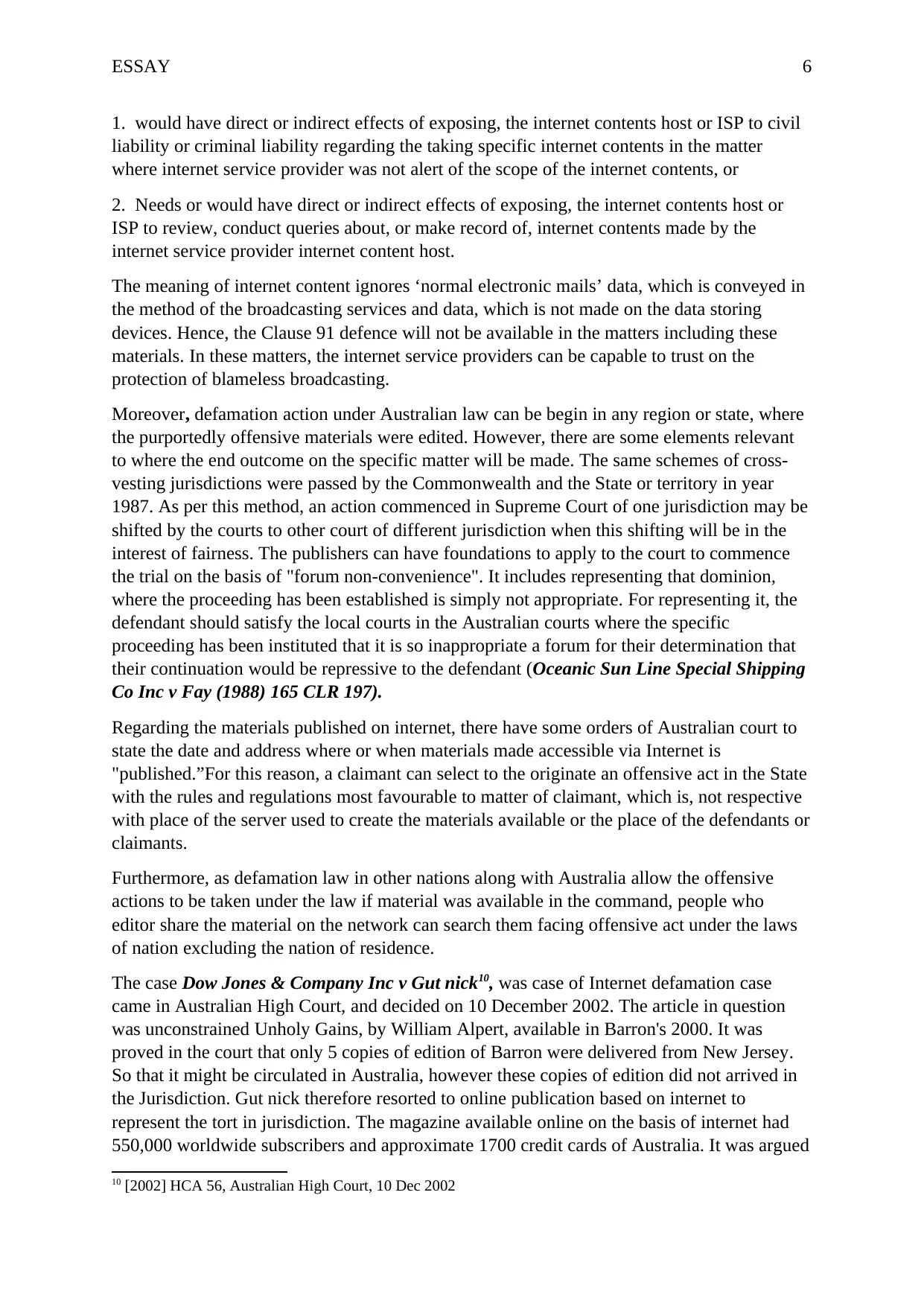
ESSAY 6
1. would have direct or indirect effects of exposing, the internet contents host or ISP to civil
liability or criminal liability regarding the taking specific internet contents in the matter
where internet service provider was not alert of the scope of the internet contents, or
2. Needs or would have direct or indirect effects of exposing, the internet contents host or
ISP to review, conduct queries about, or make record of, internet contents made by the
internet service provider internet content host.
The meaning of internet content ignores ‘normal electronic mails’ data, which is conveyed in
the method of the broadcasting services and data, which is not made on the data storing
devices. Hence, the Clause 91 defence will not be available in the matters including these
materials. In these matters, the internet service providers can be capable to trust on the
protection of blameless broadcasting.
Moreover, defamation action under Australian law can be begin in any region or state, where
the purportedly offensive materials were edited. However, there are some elements relevant
to where the end outcome on the specific matter will be made. The same schemes of cross-
vesting jurisdictions were passed by the Commonwealth and the State or territory in year
1987. As per this method, an action commenced in Supreme Court of one jurisdiction may be
shifted by the courts to other court of different jurisdiction when this shifting will be in the
interest of fairness. The publishers can have foundations to apply to the court to commence
the trial on the basis of "forum non-convenience". It includes representing that dominion,
where the proceeding has been established is simply not appropriate. For representing it, the
defendant should satisfy the local courts in the Australian courts where the specific
proceeding has been instituted that it is so inappropriate a forum for their determination that
their continuation would be repressive to the defendant (Oceanic Sun Line Special Shipping
Co Inc v Fay (1988) 165 CLR 197).
Regarding the materials published on internet, there have some orders of Australian court to
state the date and address where or when materials made accessible via Internet is
"published.”For this reason, a claimant can select to the originate an offensive act in the State
with the rules and regulations most favourable to matter of claimant, which is, not respective
with place of the server used to create the materials available or the place of the defendants or
claimants.
Furthermore, as defamation law in other nations along with Australia allow the offensive
actions to be taken under the law if material was available in the command, people who
editor share the material on the network can search them facing offensive act under the laws
of nation excluding the nation of residence.
The case Dow Jones & Company Inc v Gut nick10, was case of Internet defamation case
came in Australian High Court, and decided on 10 December 2002. The article in question
was unconstrained Unholy Gains, by William Alpert, available in Barron's 2000. It was
proved in the court that only 5 copies of edition of Barron were delivered from New Jersey.
So that it might be circulated in Australia, however these copies of edition did not arrived in
the Jurisdiction. Gut nick therefore resorted to online publication based on internet to
represent the tort in jurisdiction. The magazine available online on the basis of internet had
550,000 worldwide subscribers and approximate 1700 credit cards of Australia. It was argued
10 [2002] HCA 56, Australian High Court, 10 Dec 2002
1. would have direct or indirect effects of exposing, the internet contents host or ISP to civil
liability or criminal liability regarding the taking specific internet contents in the matter
where internet service provider was not alert of the scope of the internet contents, or
2. Needs or would have direct or indirect effects of exposing, the internet contents host or
ISP to review, conduct queries about, or make record of, internet contents made by the
internet service provider internet content host.
The meaning of internet content ignores ‘normal electronic mails’ data, which is conveyed in
the method of the broadcasting services and data, which is not made on the data storing
devices. Hence, the Clause 91 defence will not be available in the matters including these
materials. In these matters, the internet service providers can be capable to trust on the
protection of blameless broadcasting.
Moreover, defamation action under Australian law can be begin in any region or state, where
the purportedly offensive materials were edited. However, there are some elements relevant
to where the end outcome on the specific matter will be made. The same schemes of cross-
vesting jurisdictions were passed by the Commonwealth and the State or territory in year
1987. As per this method, an action commenced in Supreme Court of one jurisdiction may be
shifted by the courts to other court of different jurisdiction when this shifting will be in the
interest of fairness. The publishers can have foundations to apply to the court to commence
the trial on the basis of "forum non-convenience". It includes representing that dominion,
where the proceeding has been established is simply not appropriate. For representing it, the
defendant should satisfy the local courts in the Australian courts where the specific
proceeding has been instituted that it is so inappropriate a forum for their determination that
their continuation would be repressive to the defendant (Oceanic Sun Line Special Shipping
Co Inc v Fay (1988) 165 CLR 197).
Regarding the materials published on internet, there have some orders of Australian court to
state the date and address where or when materials made accessible via Internet is
"published.”For this reason, a claimant can select to the originate an offensive act in the State
with the rules and regulations most favourable to matter of claimant, which is, not respective
with place of the server used to create the materials available or the place of the defendants or
claimants.
Furthermore, as defamation law in other nations along with Australia allow the offensive
actions to be taken under the law if material was available in the command, people who
editor share the material on the network can search them facing offensive act under the laws
of nation excluding the nation of residence.
The case Dow Jones & Company Inc v Gut nick10, was case of Internet defamation case
came in Australian High Court, and decided on 10 December 2002. The article in question
was unconstrained Unholy Gains, by William Alpert, available in Barron's 2000. It was
proved in the court that only 5 copies of edition of Barron were delivered from New Jersey.
So that it might be circulated in Australia, however these copies of edition did not arrived in
the Jurisdiction. Gut nick therefore resorted to online publication based on internet to
represent the tort in jurisdiction. The magazine available online on the basis of internet had
550,000 worldwide subscribers and approximate 1700 credit cards of Australia. It was argued
10 [2002] HCA 56, Australian High Court, 10 Dec 2002
Paraphrase This Document
Need a fresh take? Get an instant paraphrase of this document with our AI Paraphraser
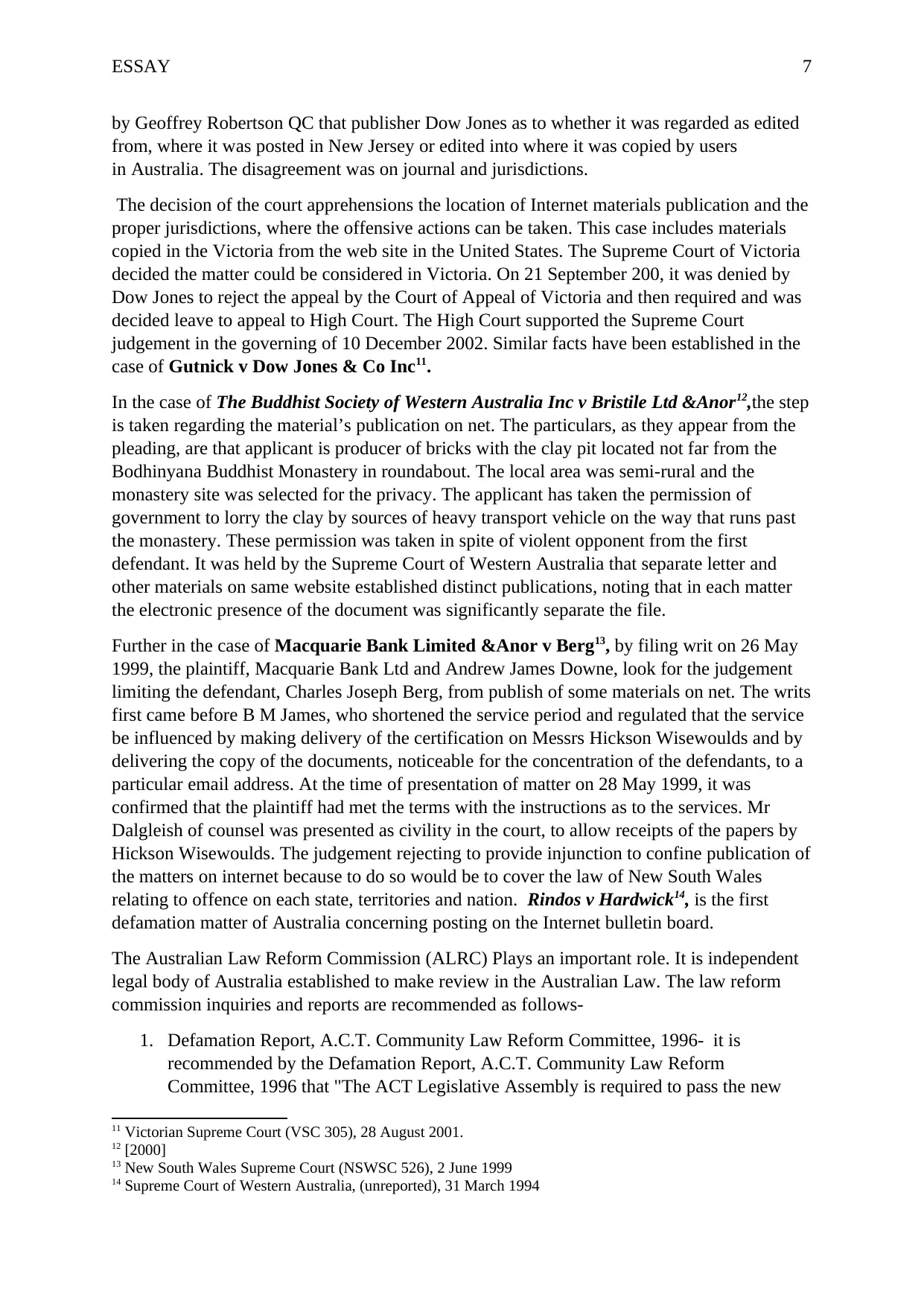
ESSAY 7
by Geoffrey Robertson QC that publisher Dow Jones as to whether it was regarded as edited
from, where it was posted in New Jersey or edited into where it was copied by users
in Australia. The disagreement was on journal and jurisdictions.
The decision of the court apprehensions the location of Internet materials publication and the
proper jurisdictions, where the offensive actions can be taken. This case includes materials
copied in the Victoria from the web site in the United States. The Supreme Court of Victoria
decided the matter could be considered in Victoria. On 21 September 200, it was denied by
Dow Jones to reject the appeal by the Court of Appeal of Victoria and then required and was
decided leave to appeal to High Court. The High Court supported the Supreme Court
judgement in the governing of 10 December 2002. Similar facts have been established in the
case of Gutnick v Dow Jones & Co Inc11.
In the case of The Buddhist Society of Western Australia Inc v Bristile Ltd &Anor12,the step
is taken regarding the material’s publication on net. The particulars, as they appear from the
pleading, are that applicant is producer of bricks with the clay pit located not far from the
Bodhinyana Buddhist Monastery in roundabout. The local area was semi-rural and the
monastery site was selected for the privacy. The applicant has taken the permission of
government to lorry the clay by sources of heavy transport vehicle on the way that runs past
the monastery. These permission was taken in spite of violent opponent from the first
defendant. It was held by the Supreme Court of Western Australia that separate letter and
other materials on same website established distinct publications, noting that in each matter
the electronic presence of the document was significantly separate the file.
Further in the case of Macquarie Bank Limited &Anor v Berg13, by filing writ on 26 May
1999, the plaintiff, Macquarie Bank Ltd and Andrew James Downe, look for the judgement
limiting the defendant, Charles Joseph Berg, from publish of some materials on net. The writs
first came before B M James, who shortened the service period and regulated that the service
be influenced by making delivery of the certification on Messrs Hickson Wisewoulds and by
delivering the copy of the documents, noticeable for the concentration of the defendants, to a
particular email address. At the time of presentation of matter on 28 May 1999, it was
confirmed that the plaintiff had met the terms with the instructions as to the services. Mr
Dalgleish of counsel was presented as civility in the court, to allow receipts of the papers by
Hickson Wisewoulds. The judgement rejecting to provide injunction to confine publication of
the matters on internet because to do so would be to cover the law of New South Wales
relating to offence on each state, territories and nation. Rindos v Hardwick14, is the first
defamation matter of Australia concerning posting on the Internet bulletin board.
The Australian Law Reform Commission (ALRC) Plays an important role. It is independent
legal body of Australia established to make review in the Australian Law. The law reform
commission inquiries and reports are recommended as follows-
1. Defamation Report, A.C.T. Community Law Reform Committee, 1996- it is
recommended by the Defamation Report, A.C.T. Community Law Reform
Committee, 1996 that "The ACT Legislative Assembly is required to pass the new
11 Victorian Supreme Court (VSC 305), 28 August 2001.
12 [2000]
13 New South Wales Supreme Court (NSWSC 526), 2 June 1999
14 Supreme Court of Western Australia, (unreported), 31 March 1994
by Geoffrey Robertson QC that publisher Dow Jones as to whether it was regarded as edited
from, where it was posted in New Jersey or edited into where it was copied by users
in Australia. The disagreement was on journal and jurisdictions.
The decision of the court apprehensions the location of Internet materials publication and the
proper jurisdictions, where the offensive actions can be taken. This case includes materials
copied in the Victoria from the web site in the United States. The Supreme Court of Victoria
decided the matter could be considered in Victoria. On 21 September 200, it was denied by
Dow Jones to reject the appeal by the Court of Appeal of Victoria and then required and was
decided leave to appeal to High Court. The High Court supported the Supreme Court
judgement in the governing of 10 December 2002. Similar facts have been established in the
case of Gutnick v Dow Jones & Co Inc11.
In the case of The Buddhist Society of Western Australia Inc v Bristile Ltd &Anor12,the step
is taken regarding the material’s publication on net. The particulars, as they appear from the
pleading, are that applicant is producer of bricks with the clay pit located not far from the
Bodhinyana Buddhist Monastery in roundabout. The local area was semi-rural and the
monastery site was selected for the privacy. The applicant has taken the permission of
government to lorry the clay by sources of heavy transport vehicle on the way that runs past
the monastery. These permission was taken in spite of violent opponent from the first
defendant. It was held by the Supreme Court of Western Australia that separate letter and
other materials on same website established distinct publications, noting that in each matter
the electronic presence of the document was significantly separate the file.
Further in the case of Macquarie Bank Limited &Anor v Berg13, by filing writ on 26 May
1999, the plaintiff, Macquarie Bank Ltd and Andrew James Downe, look for the judgement
limiting the defendant, Charles Joseph Berg, from publish of some materials on net. The writs
first came before B M James, who shortened the service period and regulated that the service
be influenced by making delivery of the certification on Messrs Hickson Wisewoulds and by
delivering the copy of the documents, noticeable for the concentration of the defendants, to a
particular email address. At the time of presentation of matter on 28 May 1999, it was
confirmed that the plaintiff had met the terms with the instructions as to the services. Mr
Dalgleish of counsel was presented as civility in the court, to allow receipts of the papers by
Hickson Wisewoulds. The judgement rejecting to provide injunction to confine publication of
the matters on internet because to do so would be to cover the law of New South Wales
relating to offence on each state, territories and nation. Rindos v Hardwick14, is the first
defamation matter of Australia concerning posting on the Internet bulletin board.
The Australian Law Reform Commission (ALRC) Plays an important role. It is independent
legal body of Australia established to make review in the Australian Law. The law reform
commission inquiries and reports are recommended as follows-
1. Defamation Report, A.C.T. Community Law Reform Committee, 1996- it is
recommended by the Defamation Report, A.C.T. Community Law Reform
Committee, 1996 that "The ACT Legislative Assembly is required to pass the new
11 Victorian Supreme Court (VSC 305), 28 August 2001.
12 [2000]
13 New South Wales Supreme Court (NSWSC 526), 2 June 1999
14 Supreme Court of Western Australia, (unreported), 31 March 1994
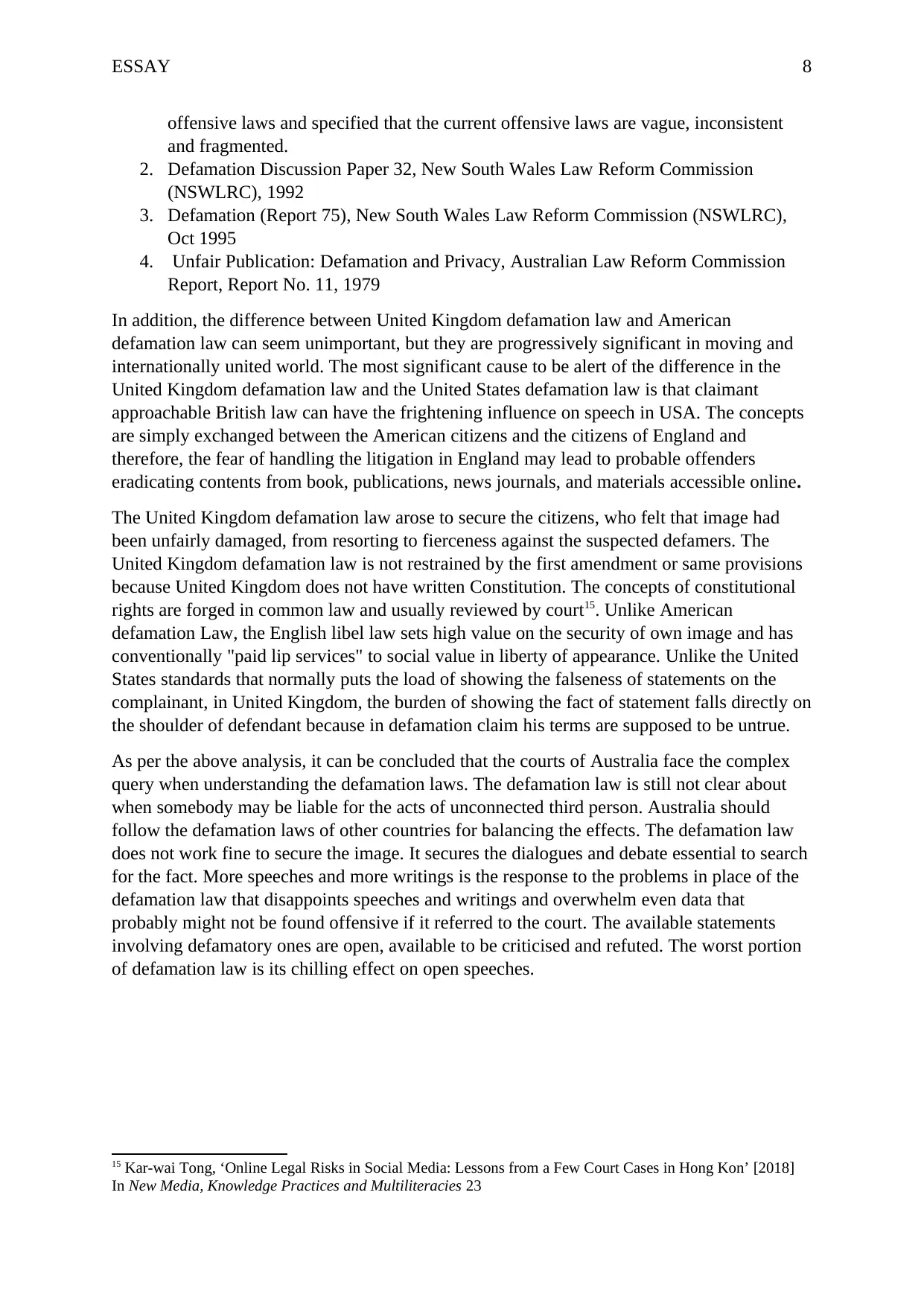
ESSAY 8
offensive laws and specified that the current offensive laws are vague, inconsistent
and fragmented.
2. Defamation Discussion Paper 32, New South Wales Law Reform Commission
(NSWLRC), 1992
3. Defamation (Report 75), New South Wales Law Reform Commission (NSWLRC),
Oct 1995
4. Unfair Publication: Defamation and Privacy, Australian Law Reform Commission
Report, Report No. 11, 1979
In addition, the difference between United Kingdom defamation law and American
defamation law can seem unimportant, but they are progressively significant in moving and
internationally united world. The most significant cause to be alert of the difference in the
United Kingdom defamation law and the United States defamation law is that claimant
approachable British law can have the frightening influence on speech in USA. The concepts
are simply exchanged between the American citizens and the citizens of England and
therefore, the fear of handling the litigation in England may lead to probable offenders
eradicating contents from book, publications, news journals, and materials accessible online.
The United Kingdom defamation law arose to secure the citizens, who felt that image had
been unfairly damaged, from resorting to fierceness against the suspected defamers. The
United Kingdom defamation law is not restrained by the first amendment or same provisions
because United Kingdom does not have written Constitution. The concepts of constitutional
rights are forged in common law and usually reviewed by court15. Unlike American
defamation Law, the English libel law sets high value on the security of own image and has
conventionally "paid lip services" to social value in liberty of appearance. Unlike the United
States standards that normally puts the load of showing the falseness of statements on the
complainant, in United Kingdom, the burden of showing the fact of statement falls directly on
the shoulder of defendant because in defamation claim his terms are supposed to be untrue.
As per the above analysis, it can be concluded that the courts of Australia face the complex
query when understanding the defamation laws. The defamation law is still not clear about
when somebody may be liable for the acts of unconnected third person. Australia should
follow the defamation laws of other countries for balancing the effects. The defamation law
does not work fine to secure the image. It secures the dialogues and debate essential to search
for the fact. More speeches and more writings is the response to the problems in place of the
defamation law that disappoints speeches and writings and overwhelm even data that
probably might not be found offensive if it referred to the court. The available statements
involving defamatory ones are open, available to be criticised and refuted. The worst portion
of defamation law is its chilling effect on open speeches.
15 Kar-wai Tong, ‘Online Legal Risks in Social Media: Lessons from a Few Court Cases in Hong Kon’ [2018]
In New Media, Knowledge Practices and Multiliteracies 23
offensive laws and specified that the current offensive laws are vague, inconsistent
and fragmented.
2. Defamation Discussion Paper 32, New South Wales Law Reform Commission
(NSWLRC), 1992
3. Defamation (Report 75), New South Wales Law Reform Commission (NSWLRC),
Oct 1995
4. Unfair Publication: Defamation and Privacy, Australian Law Reform Commission
Report, Report No. 11, 1979
In addition, the difference between United Kingdom defamation law and American
defamation law can seem unimportant, but they are progressively significant in moving and
internationally united world. The most significant cause to be alert of the difference in the
United Kingdom defamation law and the United States defamation law is that claimant
approachable British law can have the frightening influence on speech in USA. The concepts
are simply exchanged between the American citizens and the citizens of England and
therefore, the fear of handling the litigation in England may lead to probable offenders
eradicating contents from book, publications, news journals, and materials accessible online.
The United Kingdom defamation law arose to secure the citizens, who felt that image had
been unfairly damaged, from resorting to fierceness against the suspected defamers. The
United Kingdom defamation law is not restrained by the first amendment or same provisions
because United Kingdom does not have written Constitution. The concepts of constitutional
rights are forged in common law and usually reviewed by court15. Unlike American
defamation Law, the English libel law sets high value on the security of own image and has
conventionally "paid lip services" to social value in liberty of appearance. Unlike the United
States standards that normally puts the load of showing the falseness of statements on the
complainant, in United Kingdom, the burden of showing the fact of statement falls directly on
the shoulder of defendant because in defamation claim his terms are supposed to be untrue.
As per the above analysis, it can be concluded that the courts of Australia face the complex
query when understanding the defamation laws. The defamation law is still not clear about
when somebody may be liable for the acts of unconnected third person. Australia should
follow the defamation laws of other countries for balancing the effects. The defamation law
does not work fine to secure the image. It secures the dialogues and debate essential to search
for the fact. More speeches and more writings is the response to the problems in place of the
defamation law that disappoints speeches and writings and overwhelm even data that
probably might not be found offensive if it referred to the court. The available statements
involving defamatory ones are open, available to be criticised and refuted. The worst portion
of defamation law is its chilling effect on open speeches.
15 Kar-wai Tong, ‘Online Legal Risks in Social Media: Lessons from a Few Court Cases in Hong Kon’ [2018]
In New Media, Knowledge Practices and Multiliteracies 23
⊘ This is a preview!⊘
Do you want full access?
Subscribe today to unlock all pages.

Trusted by 1+ million students worldwide
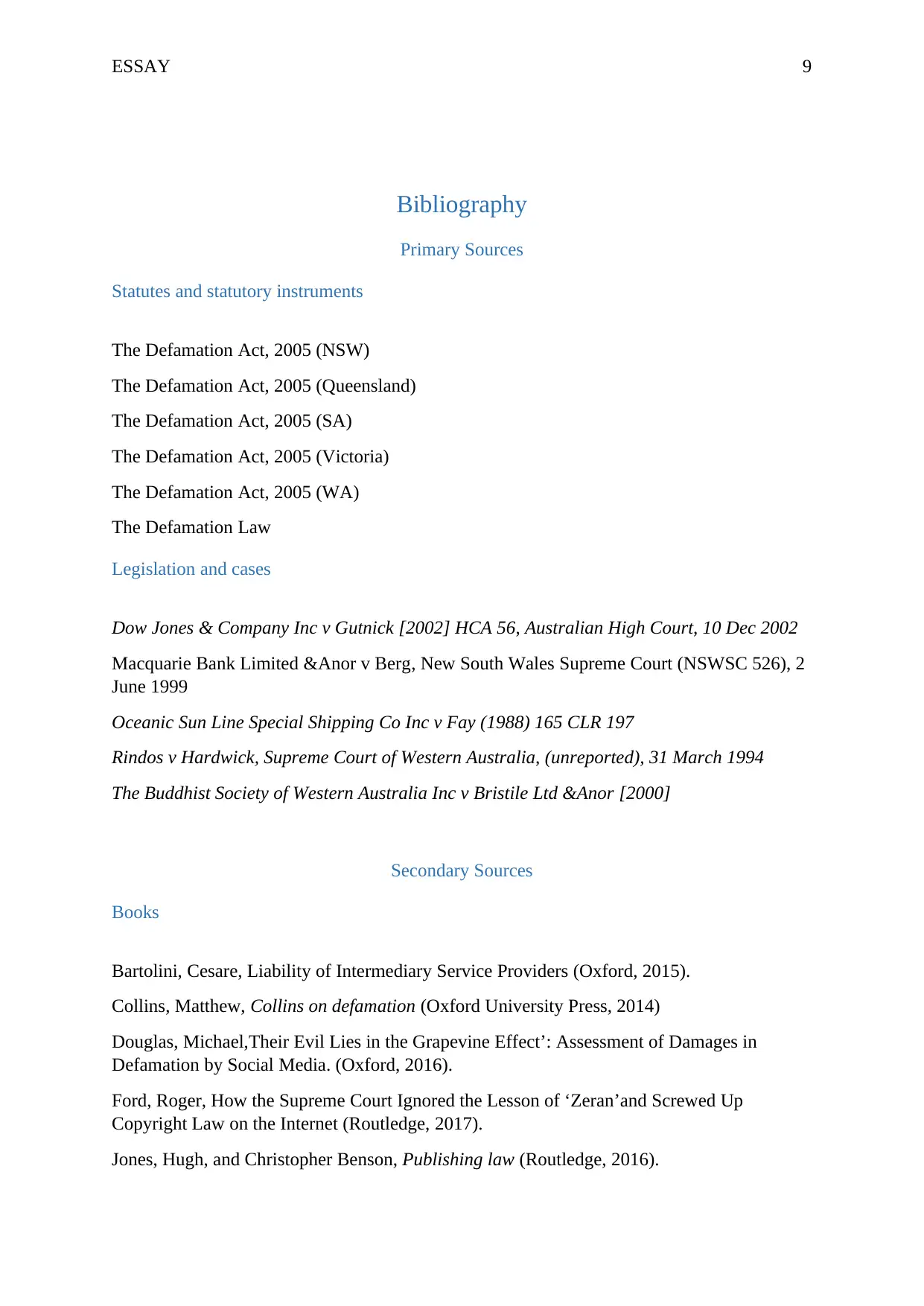
ESSAY 9
Bibliography
Primary Sources
Statutes and statutory instruments
The Defamation Act, 2005 (NSW)
The Defamation Act, 2005 (Queensland)
The Defamation Act, 2005 (SA)
The Defamation Act, 2005 (Victoria)
The Defamation Act, 2005 (WA)
The Defamation Law
Legislation and cases
Dow Jones & Company Inc v Gutnick [2002] HCA 56, Australian High Court, 10 Dec 2002
Macquarie Bank Limited &Anor v Berg, New South Wales Supreme Court (NSWSC 526), 2
June 1999
Oceanic Sun Line Special Shipping Co Inc v Fay (1988) 165 CLR 197
Rindos v Hardwick, Supreme Court of Western Australia, (unreported), 31 March 1994
The Buddhist Society of Western Australia Inc v Bristile Ltd &Anor [2000]
Secondary Sources
Books
Bartolini, Cesare, Liability of Intermediary Service Providers (Oxford, 2015).
Collins, Matthew, Collins on defamation (Oxford University Press, 2014)
Douglas, Michael,Their Evil Lies in the Grapevine Effect’: Assessment of Damages in
Defamation by Social Media. (Oxford, 2016).
Ford, Roger, How the Supreme Court Ignored the Lesson of ‘Zeran’and Screwed Up
Copyright Law on the Internet (Routledge, 2017).
Jones, Hugh, and Christopher Benson, Publishing law (Routledge, 2016).
Bibliography
Primary Sources
Statutes and statutory instruments
The Defamation Act, 2005 (NSW)
The Defamation Act, 2005 (Queensland)
The Defamation Act, 2005 (SA)
The Defamation Act, 2005 (Victoria)
The Defamation Act, 2005 (WA)
The Defamation Law
Legislation and cases
Dow Jones & Company Inc v Gutnick [2002] HCA 56, Australian High Court, 10 Dec 2002
Macquarie Bank Limited &Anor v Berg, New South Wales Supreme Court (NSWSC 526), 2
June 1999
Oceanic Sun Line Special Shipping Co Inc v Fay (1988) 165 CLR 197
Rindos v Hardwick, Supreme Court of Western Australia, (unreported), 31 March 1994
The Buddhist Society of Western Australia Inc v Bristile Ltd &Anor [2000]
Secondary Sources
Books
Bartolini, Cesare, Liability of Intermediary Service Providers (Oxford, 2015).
Collins, Matthew, Collins on defamation (Oxford University Press, 2014)
Douglas, Michael,Their Evil Lies in the Grapevine Effect’: Assessment of Damages in
Defamation by Social Media. (Oxford, 2016).
Ford, Roger, How the Supreme Court Ignored the Lesson of ‘Zeran’and Screwed Up
Copyright Law on the Internet (Routledge, 2017).
Jones, Hugh, and Christopher Benson, Publishing law (Routledge, 2016).
Paraphrase This Document
Need a fresh take? Get an instant paraphrase of this document with our AI Paraphraser
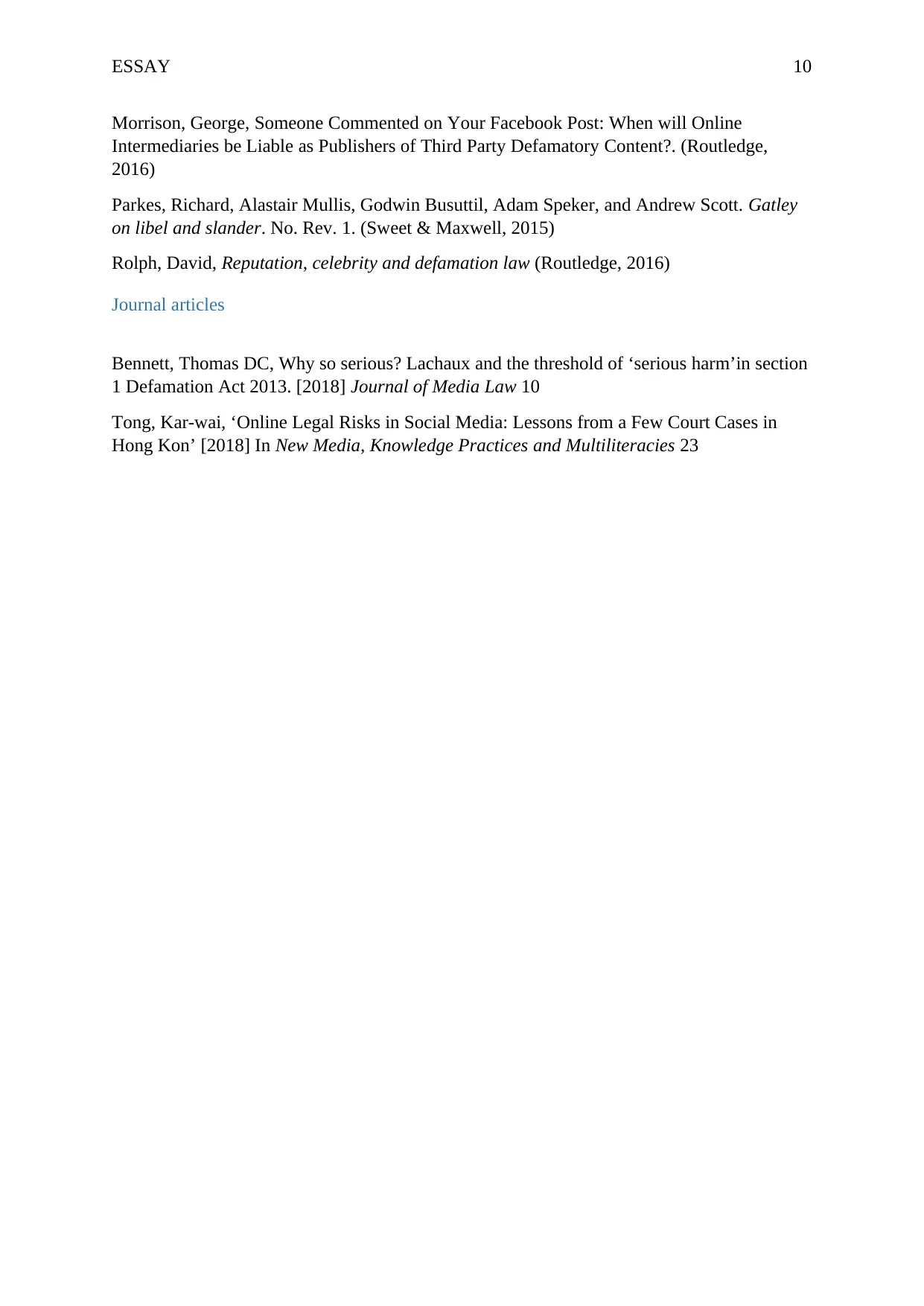
ESSAY 10
Morrison, George, Someone Commented on Your Facebook Post: When will Online
Intermediaries be Liable as Publishers of Third Party Defamatory Content?. (Routledge,
2016)
Parkes, Richard, Alastair Mullis, Godwin Busuttil, Adam Speker, and Andrew Scott. Gatley
on libel and slander. No. Rev. 1. (Sweet & Maxwell, 2015)
Rolph, David, Reputation, celebrity and defamation law (Routledge, 2016)
Journal articles
Bennett, Thomas DC, Why so serious? Lachaux and the threshold of ‘serious harm’in section
1 Defamation Act 2013. [2018] Journal of Media Law 10
Tong, Kar-wai, ‘Online Legal Risks in Social Media: Lessons from a Few Court Cases in
Hong Kon’ [2018] In New Media, Knowledge Practices and Multiliteracies 23
Morrison, George, Someone Commented on Your Facebook Post: When will Online
Intermediaries be Liable as Publishers of Third Party Defamatory Content?. (Routledge,
2016)
Parkes, Richard, Alastair Mullis, Godwin Busuttil, Adam Speker, and Andrew Scott. Gatley
on libel and slander. No. Rev. 1. (Sweet & Maxwell, 2015)
Rolph, David, Reputation, celebrity and defamation law (Routledge, 2016)
Journal articles
Bennett, Thomas DC, Why so serious? Lachaux and the threshold of ‘serious harm’in section
1 Defamation Act 2013. [2018] Journal of Media Law 10
Tong, Kar-wai, ‘Online Legal Risks in Social Media: Lessons from a Few Court Cases in
Hong Kon’ [2018] In New Media, Knowledge Practices and Multiliteracies 23
1 out of 11
Your All-in-One AI-Powered Toolkit for Academic Success.
+13062052269
info@desklib.com
Available 24*7 on WhatsApp / Email
![[object Object]](/_next/static/media/star-bottom.7253800d.svg)
Unlock your academic potential
Copyright © 2020–2025 A2Z Services. All Rights Reserved. Developed and managed by ZUCOL.

